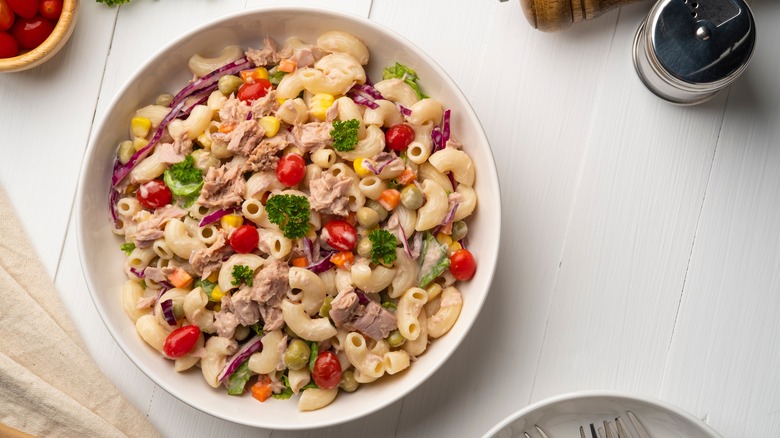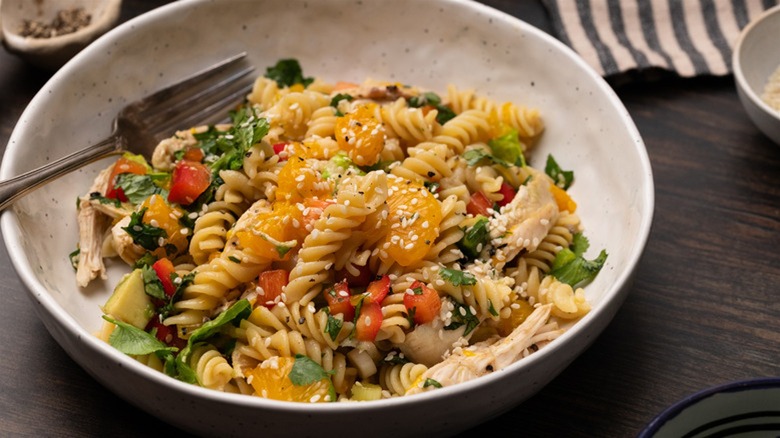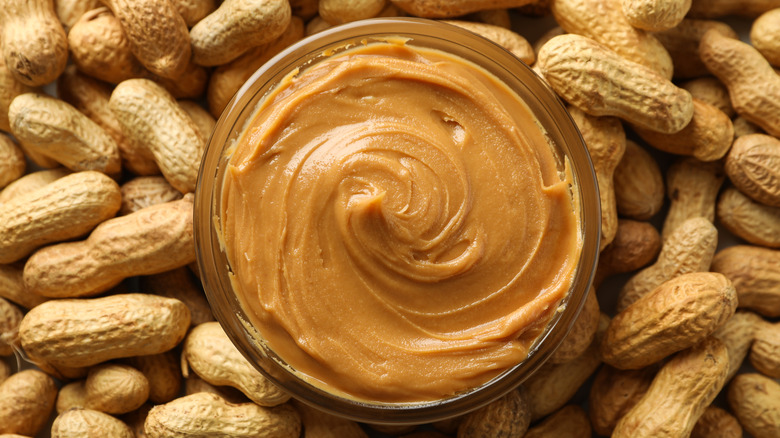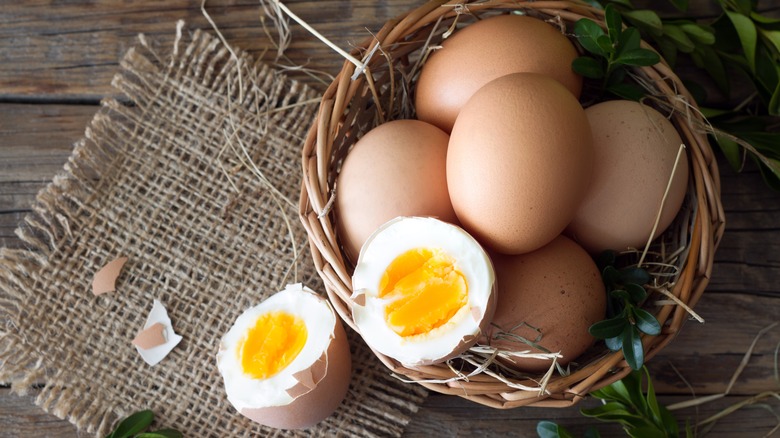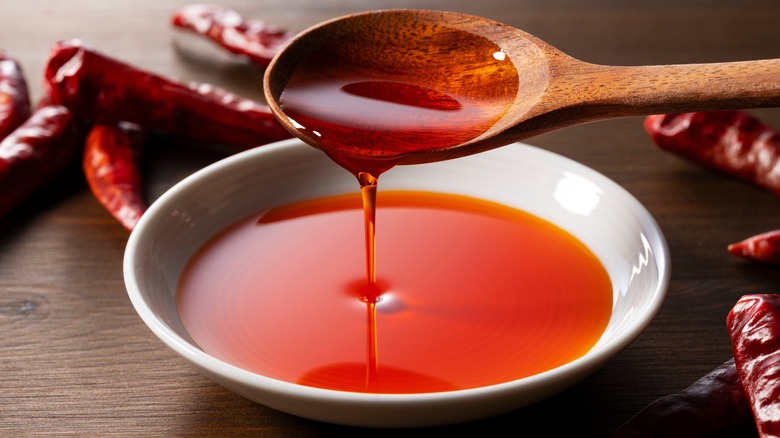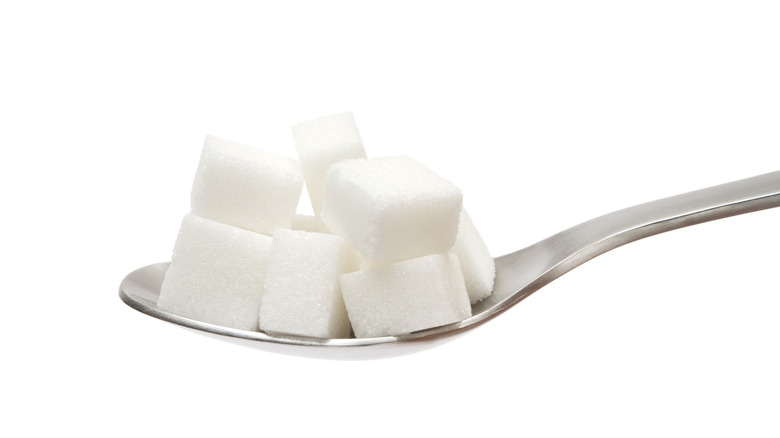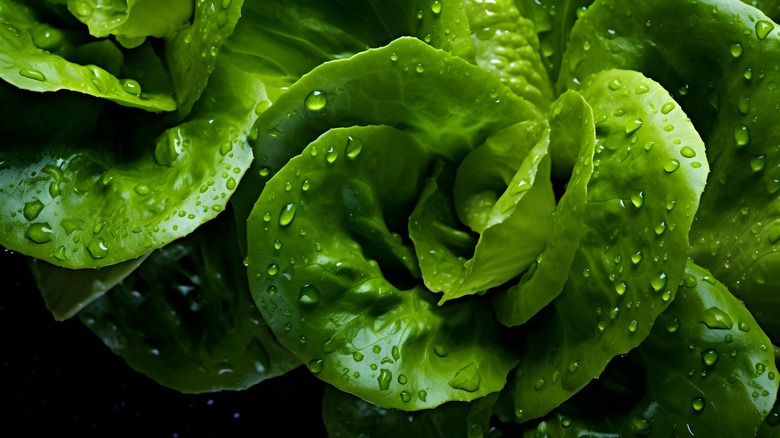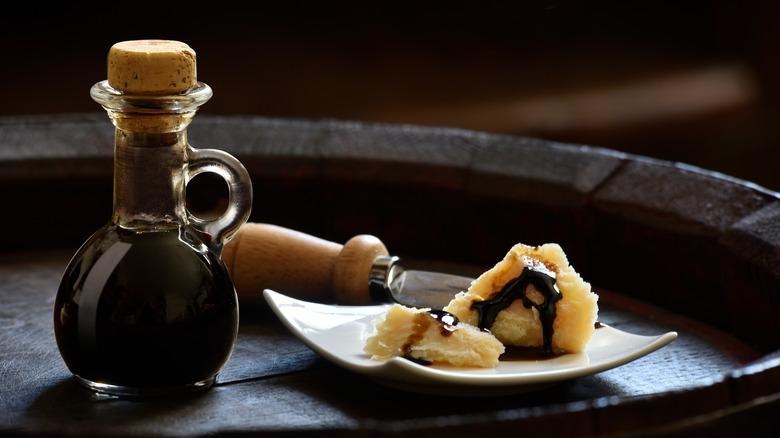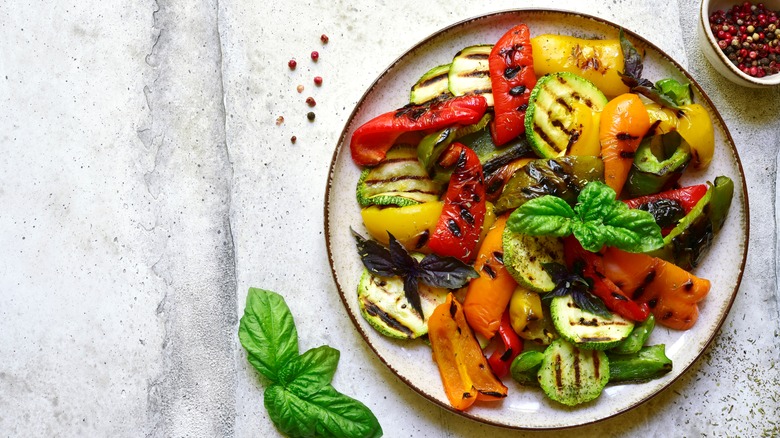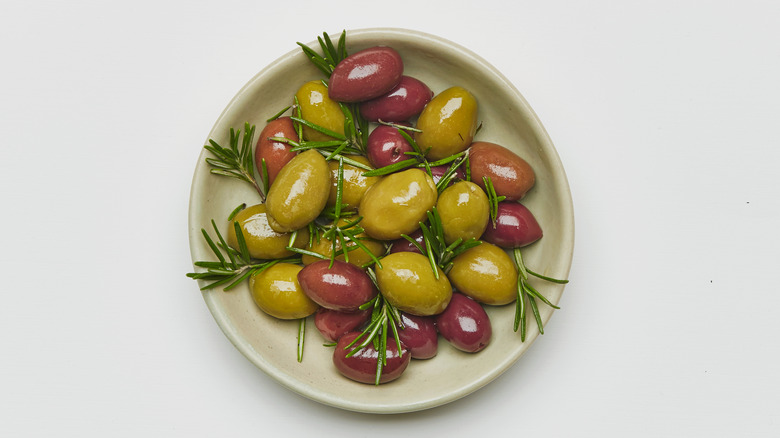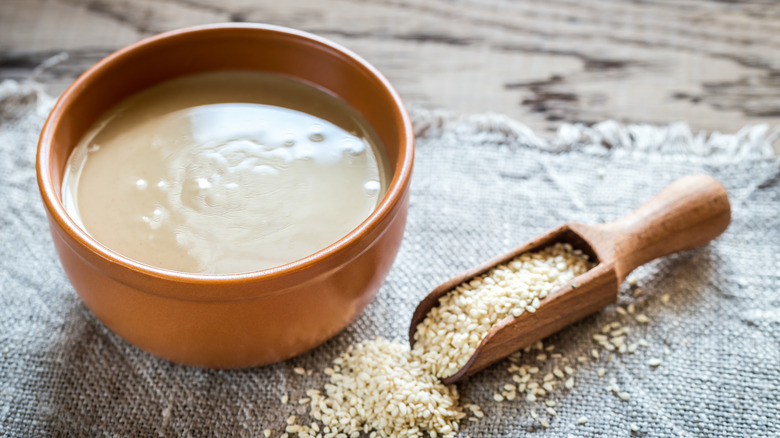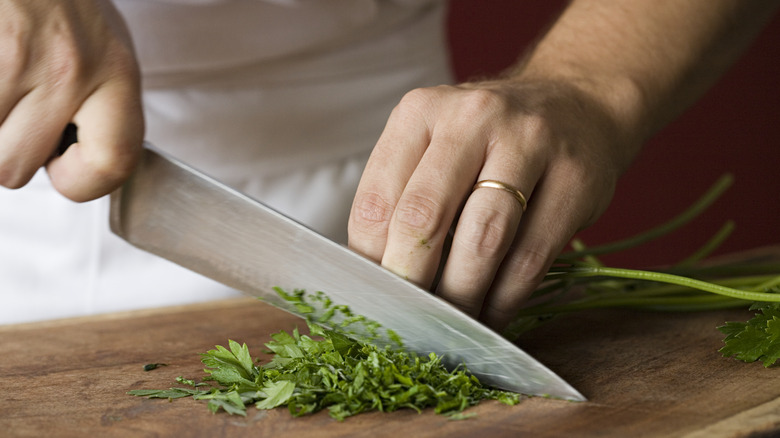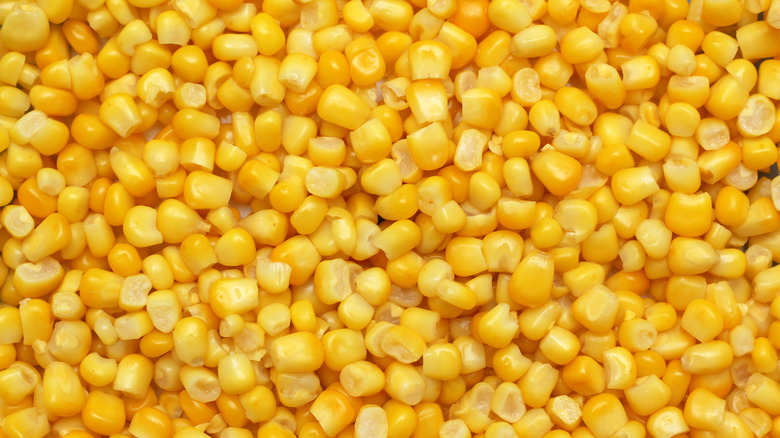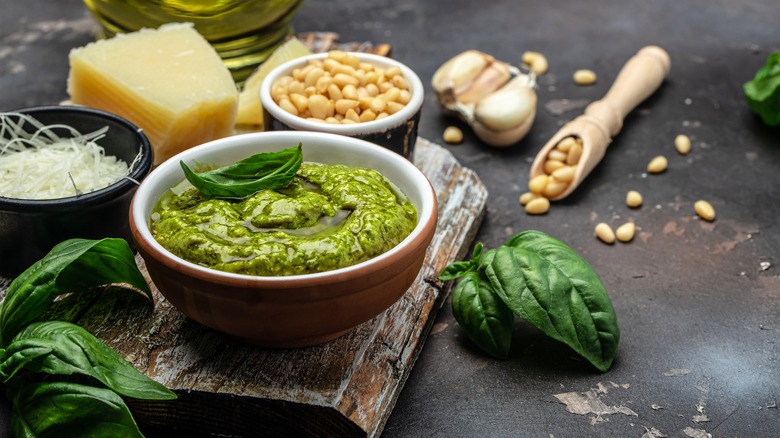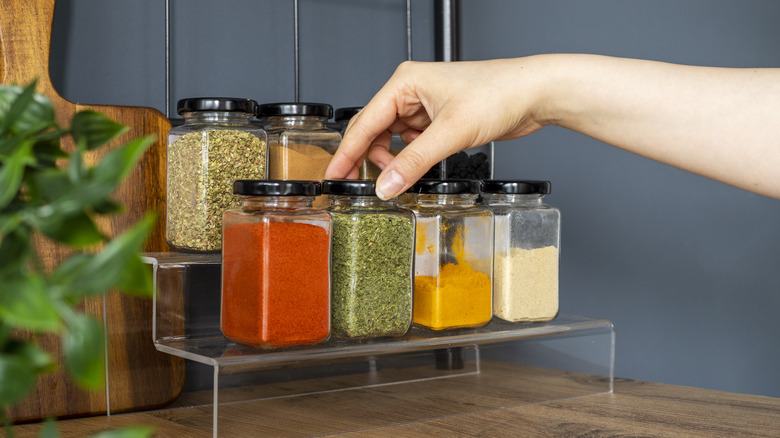14 Ingredients That Will Seriously Upgrade Your Pasta Salad
If you're looking for something crowd pleasing to bring to a potluck or summer barbecue, look no further than pasta salad. Unlike lettuce, pasta doesn't wilt in the heat (a mandatory quality when you're making food for an outdoor summer gathering), and it's much more filling. Pasta salad also makes a great contribution because no two iterations of the dish are alike, meaning that even if another guest turns up with their version, it won't be redundant. You might use fusilli while they use macaroni. Theirs might be creamy while yours is vinegary. One of you might have focused on cheese and bacon while the other focused on vegetables. Pasta salad is infinitely adaptable. It can be healthy or indulgent, a main course or a side dish. Come to think of it, there aren't very many savory ingredients that don't work in pasta salad, and finding new ways to spice up the dish is simply a matter of imagination rather than resources.
That does not mean, however, that pasta salad is impossible to mess up. There are several tips to keep in mind if you want to learn how to make the ultimate pasta salad. For example, contrast and proportion are key. You don't want to end up with one overwhelming flavor or so many ingredients that you can barely spot the pasta. Before you start your next foray into the realm of pasta salad, keep reading to discover some of the best ingredients to include in your recipe.
1. Fruit
Summer brings such a bounty of fresh fruit that it would be a shame to leave it out of any meal, even a savory one. Pasta salad is a great way to incorporate a sweet element into the proceedings because it can handle more daring flavor combinations than, for example, hotdogs or hamburgers. Because it is a versatile dish, you can adapt pasta salad to fit any ingredients you want to throw in.
Citrus is a safe place to start when adding sweetness to savory dishes. With its acidity, it cuts through grease and brightens rich, umami flavors without leaving a sickly sweet taste in the mouth. This mandarin chicken pasta salad revolves around Asian-style flavors, including the sweetness of citrus, the umami of soy sauce, and the meatiness of chicken. Chock-full of interdependent flavors, this is not your average pasta salad. In addition to pasta, mandarin oranges, soy sauce, and chicken, you'll need toasted sesame oil, ginger paste, maple syrup or honey, avocado, and bell peppers. Full of contrasting flavors and textures, this salad is sure to stand out at your next meal and have your guests coming back for seconds.
2. Peanut butter
There's no question that pasta salad can accommodate many ingredients, be it a vegetable, a condiment, or a protein, but even the most inventive and resourceful cooks might balk at the idea of using peanut butter. It might taste delicious in a sandwich or in a chocolate-based dessert, but in pasta salad? Probably not. However, when paired with a few other ingredients, peanut butter can be the foundation of a truly mouthwatering pasta-based dish, and it won't just appeal to adventurous eaters, either.
This peanut soba noodle salad recipe will convince you that peanut butter and pasta do belong together. It also takes you off the beaten track by using Japanese buckwheat noodles (called soba noodles) instead of the same old fusilli or penne. Full of veggies, it is also healthy and filling. What more could you ask for? The peanut butter is the base ingredient of the dressing, which also includes minced garlic and ginger, soy sauce, sesame oil, and seasoned rice vinegar. The richness of the peanut butter lends a luxurious feel to the crunchy fresh vegetables, while the other ingredients in the recipe transform the PBJ staple into something deliciously savory and vibrant.
3. Hard-boiled eggs
Pasta salad can be the healthy part of a meal, but it can also be the indulgent part. Add some mayonnaise and cheese, bacon and cream, and you're in for a side dish that is the definition of rich and luxurious.
When you really want to step up your pasta salad game, however, hard-boiled eggs will do the trick, as our loaded deviled egg pasta salad recipe proves. It doesn't simply incorporate the creaminess of boiled egg yolks into things, it turns them into a deviled eggs-style dressing. In addition to the yolks, the creamy sauce contains onion, mayonnaise, Dijon mustard, apple cider vinegar, salt, and pepper. This velvety mixture is poured over the pasta, which is mixed with chopped egg whites, pimentos, Cheddar cheese, and bacon for good measure. Full of delicious textures and a decadent combination of flavors, this pasta salad will turn any meal into a special occasion.
4. Chili oil
If you like adding jalapeños to your nachos, Sriracha to your scrambled eggs, and a dash of cayenne to your soups, you're probably wondering why pasta salad is so darn bland. Many versions use mayo as a key ingredient, with only a few grinds of black pepper to inject some warmth. However, adding extra heat will elevate many pasta salad recipes, and you don't need to find one that specifically contains spicy ingredients. Simply procure a bottle of chili oil and toss it with your cooked pasta before assembling the rest of the components.
This method won't work with every recipe. For example, you might not want to add chili oil to a pasta salad made with a vinegar-based dressing since the sharpness of the vinegar and heat of the chili oil may clash. However, if you're making a salad with a simple savory dressing featuring ingredients like soy sauce, garlic, or even mayonnaise, a dash of chili oil will add some much-needed spark to the recipe.
5. Sugar
Sugar isn't just for dessert. It balances other flavors, ensuring nothing is too bitter, too sour, or too salty. In pasta salad, which is often overflowing with ingredients, it can act as a unifier, ensuring that no flavor sticks out in an unpleasant or unharmonious way. Although it might sound risky, sugar is fairly common in pasta salad recipes. For example, this Hawaiian macaroni salad recipe from Tasting Table calls for adding one teaspoon of it to the mayonnaise and milk dressing. It works so seamlessly with the other ingredients that it isn't even mentioned in the recipe as a standout addition. The resulting dish tastes smooth and cohesive rather than overtly sweet.
As the Hawaiian macaroni salad demonstrates, a little sugar goes a long way. A single teaspoon is enough to take the edge off the other ingredients or subtly remove the distinctive flavor of mayonnaise, so make sure to add only a small amount. Just a hint of it will dull the sharpness of the acid and allow all the other flavors to shine through.
6. Lettuce
If your pasta salad does not have to be heat-proof (in other words, it won't be sitting out in the sun at a barbecue), lettuce might be your new favorite ingredient to add. Even though the lack of greens is a major selling point for some eaters, it can be a surprising ingredient that adds texture, flavor, and nutrition. When adding lettuce to pasta salad, proportions are key. If pasta dominates the bowl, the lettuce will be too subtle to make an impression. The best option is to err on the side of more lettuce and less pasta. For example, our creamy tortellini pasta salad recipe calls for a whole head of romaine combined with 20 ounces of tortellini. This way, every bite will have both lettuce and pasta, but not so much of the latter that you miss the crunch and moisture of the former.
This caesar chicken pasta salad recipe from Tasting Table takes this principle one step further, demoting the pasta to the same level as the chicken, anchovies, and croutons in terms of prominence. As a result, these salads are more like lettuce salad with pasta than pasta salad with lettuce, and once you try them, you'll likely find that it is the perfect balance.
7. Balsamic vinegar
Sometimes, the role of a side dish is to add a bright zing of flavor to complement a relatively mild main dish like fish or chicken. In these instances, a sharp, acidic ingredient will do all the heavy lifting you need. Balsamic vinegar is an excellent option for this because it adds both acidity and sweetness, two elements that will provide depth and complexity to the whole meal, not just the salad.
This balsamic caprese pasta salad recipe showcases the ingredient in all its glory. The basic components of a caprese salad are already pitch-perfect, and when you bulk them up with pasta and add a hint of balsamic vinegar, they become the star of any meal. This recipe calls for grape tomatoes, penne pasta, honey, Dijon mustard for an extra kick of flavor, garlic powder, mozzarella pearls, basil, and, of course, balsamic vinegar. Instead of simply drizzling the vinegar on top of the assembled ingredients, it calls for marinating the tomatoes in it before assembling the rest of the ingredients. Paired with a little salt, it suffuses the tomatoes with flavor, making the entire recipe full of vinegary deliciousness rather than merely featuring in a superficial layer of dressing.
8. Grilled or roasted veggies
Just because pasta salad is served cold doesn't mean it has to have only raw ingredients. As soon as you start exploring all the different ways there are to cook different vegetables, you'll unlock a whole new tier of flavors, whether you're sautéing mushrooms in butter or caramelizing onions. Grilling and roasting vegetables creates more flavor and a softer texture. Instead of sticking with raw carrots and tomatoes in your pasta salad, try the creamy smokiness of roasted eggplant or the sweet, caramelized taste of grilled zucchini. These cooking options add extra time to an otherwise speedy dish, but you won't regret it.
Our recipe for grilled summer vegetable pasta salad is a prime example of how delicious a little bit of charring can make your veggies. They have so much flavor after spending 15 minutes on the grill that you hardly need to worry about making a dressing. This recipe calls for a simple dressing of balsamic vinegar, olive oil, garlic salt, oregano, and cumin, but it's the veggies that do most of the talking.
9. Olives
Even though they are technically a fruit, olives play their own particular role in cooking. They aren't sweet like a stereotypical fruit, nor are they similar to vegetables. With their intense flavors, they are more like a condiment than anything else, and this nebulous categorization can make them easy to forget. Leaving them out of the equation is unfortunate, however, because they make delicious additions to a wide range of dishes, from salads to pizzas. Adding them to pasta salad is one of the easiest ways to dial up the flavor of the dish without even having to touch your spice rack.
If you're looking for inspiration, this veggie antipasti Italian pasta salad recipe has all the ideas and guidance you need to make a deliciously olive-filled pasta dish. In addition to two types of olives (Kalamata and green), it calls for hearts of palm and artichoke hearts, both of which lend a meaty texture to the pasta. You might even find that this recipe can stand alone as a main dish. With a light lemon dressing, balls of mozzarella, and fresh tomatoes and red onion, this recipe is chock-full of flavors and is bound to satisfy anyone craving the best of what Mediterranean cuisine has to offer.
10. Tahini
If you already have a go-to set of ingredients that you use in pasta salad, a quick way to transform them is by changing the dressing. Keep the tomatoes, red onion, bell pepper, feta, and cucumber and swap the usual vinaigrette or mayonnaise dressing with tahini. Made by turning toasted sesame seeds and oil into a paste, tahini is creamy like nut butter but has a slightly bitter flavor and more runny consistency. It is the perfect base ingredient for salad dressing because it is full of oil, but, unlike olive oil, also comes with a rich, nutty flavor and creamy texture.
There are many ways to turn tahini into pasta salad dressing. You can make things as simple as mixing it with lemon and garlic salt or opt for more involved recipes that have Dijon mustard, minced garlic, olive oil, Greek yogurt, or cayenne. If your tahini tastes bitter, do not be afraid to add a teaspoon of honey or maple syrup to provide balance.
11. Fresh herbs
Anytime you add fresh herbs to a dish, you immediately add a touch of sophistication. It's one of those culinary hacks that you can draw on with just about any recipe. Forgotten to make a dessert for the dinner party and have nothing but vanilla ice cream to serve your guests? Add a few mint leaves and it will look gourmet. Have no ingredients to make salad except lettuce and a bottle of Ranch? No problem. Just sprinkle some parsley or thyme over the top and it will taste like it's come from a fancy farm-to-table bistro. Adding fresh herbs to pasta salad has the same effect. Whether you're trying to lighten up a heavy mayonnaise-based recipe or add some flavor when you're running low on ingredients, they provide exactly what you need, and then some.
Before you head off to the produce aisle or, if you're lucky, your garden, it's worth going through the common types of herbs and how to use them. Basil is sweet, citrusy, and peppery, perfect for pairing with fresh summer veggies and a vinaigrette. Sage has a deeper, more musky flavor and is often paired with meat. If you're making a pasta salad with chicken, fresh sage will be the proverbial icing on the cake. If you want an all-rounder, chives will complement almost any pasta salad recipe. With a less sharp oniony flavor than actual onions and a slightly sweet, spicy aftertaste, they fit seamlessly with creamy, vinegary, and starchy recipes.
12. Corn
Incorporating juicy elements into pasta salad ensures that the dish doesn't become gluey. When combined with mayonnaise, pasta can start to take on a dense, almost gummy texture that isn't particularly enjoyable to eat no matter how yummy the flavors are. Adding textural variation is crucial, but while many of us might remember to add something crunchy, it is easy to forget to add something juicy. Tomatoes can serve this purpose, but corn is arguably better, providing small pockets of sweetness that add more than just moisture.
Our bow tie pasta salad recipe shows just how easy it is to incorporate corn into your pasta salad. Simply toss it in with the other ingredients and you're all set. Just make sure to cook the corn kernels before adding them to the salad if you're using frozen corn. There is a lower standard of pathogen control for food products that have cooking instructions on the packaging as opposed to foods that are sold raw and ready to eat. If you're using frozen corn that has cooking instructions on its packaging, it's important to bring it to a boil to kill off any potential pathogens before consuming it.
13. Pesto
Pesto and pasta go together like peanut butter and jelly. And yet, the pairing is more common in hot pasta dishes than cold. Once you try it in a pasta salad, however, you'll realize that this is merely the result of habit. Pesto and pasta taste just as mouthwatering in a cold ensemble as they do at any other temperature, and we've got the recipe to prove it.
This summer pesto pasta salad is far from the gluey, mayonnaise-drenched recipes you might be familiar with. Made with grape tomatoes, balls of mozzarella, Parmigiano Reggiano cheese, arugula, red onion, fresh basil, and pesto, it is bursting with peppery, garlicky summer flavors that will brighten up even the most basic main dishes. Pair this with nothing more than some grilled meat and you'll have a delicious, flavorful meal. Add some shrimp to the ingredients list and it becomes a complete meal on its own. Quick to make and full of healthy ingredients, it will quickly become your go-to pasta salad recipe.
14. Spices
If your pasta salad turns out bland despite your best efforts, it's time to bust out your spice drawer. There is no shortage of options (depending on your inventory). From a simple dash of cayenne to add some heat to a sprinkling of cumin to add some slight sweetness and warmth without upending the balance of the other ingredients, there is a spice to fit every niche and every gap in flavor.
Mixing your own blend of spices is also a way to put a personal stamp on the recipe. If you have a handful of flavors you love, turn them into a spice blend all your own. Garlic powder, paprika, salt, and pepper are a great place to start, while red pepper flakes, parmesan, and sesame seeds will make it even more distinctive. Tasting Table's Southwest pasta salad recipe calls for a blend of dried herbs and spices, including garlic powder, onion powder, dried chives, dried parsley, and dried oregano to produce a punch of flavors that set the dish apart from other mayonnaise-based pasta salads. If you're not sure where to begin, you can purchase a wide range of pre-made spice blends from the store that will fit your recipe.
Static Media owns and operates Mashed and Tasting Table.
